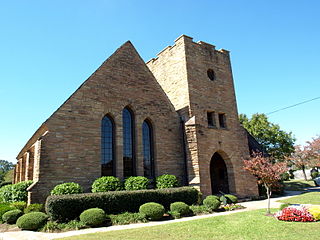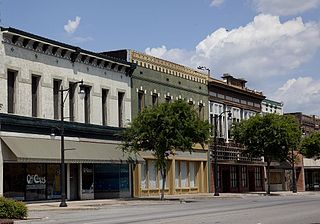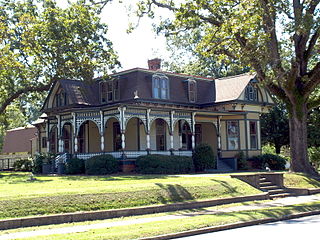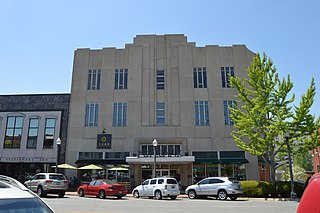
The 16th Street Baptist Church is a Baptist church in Birmingham, Alabama, United States. In 1963, the church was bombed by Ku Klux Klan members. The bombing killed four young girls in the midst of the Civil Rights Movement. The church is still in operation and is a central landmark in the Birmingham Civil Rights District. It was designated as a National Historic Landmark in 2006. Since 2008, it has also been on the UNESCO list of tentative World Heritage Sites.
The Alabama Register of Landmarks and Heritage, commonly referred to as the Alabama Register, is an official listing of buildings, sites, structures, objects, and districts deemed worthy of preservation in the U.S. state of Alabama. These properties, which may be of national, state, and local significance, are designated by the Alabama Historical Commission. The designation is honorary and carries no direct restrictions or incentives. The register includes properties such as cemeteries, churches, moved properties, reconstructed properties, and properties at least 40 years old which may not normally qualify for listing in the National Register of Historic Places. There are approximately 1421 properties and districts listed on the Alabama Register. Of these, approximately 196 are also listed on the National Register of Historic Places and 5 are designated as National Historic Landmarks.

Stone Street Baptist Church is a historic African-American Baptist church in Mobile, Alabama. The congregation was established well before the American Civil War, with Stone Street Baptist recognized today as one of Alabama's most influential African-American Baptist churches. It was placed on the National Register of Historic Places on August 8, 1985.
This is a list of properties on the Alabama Register of Landmarks and Heritage, sorted alphabetically by county. This list contains all entries for Pickens County through Winston County, the other listings may be found here. The Alabama Register of Landmarks and Heritage is an official listing of buildings, sites, structures, objects, and districts deemed worthy of preservation in the U.S. state of Alabama.
This is a list of properties on the Alabama Register of Landmarks and Heritage, sorted alphabetically by county. This list contains all entries for Autauga County through Choctaw County, the other listings may be found here. The Alabama Register of Landmarks and Heritage is an official listing of buildings, sites, structures, objects, and districts deemed worthy of preservation in the U.S. state of Alabama.
This is a list of properties on the Alabama Register of Landmarks and Heritage, sorted alphabetically by county. This list contains all entries for Clarke County through Dallas County, the other listings may be found here. The Alabama Register of Landmarks and Heritage is an official listing of buildings, sites, structures, objects, and districts deemed worthy of preservation in the U.S. state of Alabama.
This is a list of properties on the Alabama Register of Landmarks and Heritage, sorted alphabetically by county. This list contains all entries for Madison County through Perry County, the other listings may be found here. The Alabama Register of Landmarks and Heritage is an official listing of buildings, sites, structures, objects, and districts deemed worthy of preservation in the U.S. state of Alabama.

The W. B. Davis Hosiery Mill is a historic industrial complex in Fort Payne, Alabama. It opened in 1884 in the midst of Fort Payne's economic boom, manufacturing building hardware and supplies. The main building, which features Colonial Revival details, is three stories tall, with 12-over-12 sash windows on each floor. An 85-foot (26-meter) chimney has a flared top and corbeled brick course, imitating a doric order column. By 1890, hopes that large quantities of iron ore and other minerals would be discovered in the Fort Payne district proved to be ill-founded. The ABHMC and seven of Fort Payne's other large manufacturers merged in an effort to remain in business, but they were unable to avoid bankruptcy.

The Howard Gardner Nichols Memorial Library is a historic building in Gadsden, Alabama, United States. The library was built in 1902 by the Nichols family, owners of the Dwight Manufacturing Company. It is named in honor of their son, who was badly injured while supervising the construction of the company's mill in what was then Alabama City. He died several days later.

The Alabama City Wall Street Historic District is a historic district in Gadsden, Alabama. Wall Street was the main commercial street in the town of Alabama City. The city was founded in 1891 halfway between Gadsden and Attalla, with intentions of becoming the major industrial hub of Northeast Alabama. In 1895 the town landed its first major concern, a cotton mill built by the Dwight Manufacturing Company of Chicopee, Massachusetts. Its second major factory, the Alabama Steel and Wire Company, was opened in 1902. By 1915, a thriving commercial district had grown up around 7th Avenue, which became known as "Little Wall Street". A fire in 1927 damaged or destroyed many structures along Wall Street and Meighan Avenue. The city would never recover from the loss, especially as neighboring Gadsden flourished; Alabama City voted to merge into Gadsden in 1932. The architecture of the district represent the changing commercial styles of the 1910s through the 1930s. Most are constructed in simple, brick styles with parapet roofs, some with more decorative brickwork. Art Deco-influenced features such as terra cotta coping and glass tile accents are present on later buildings. Other notable buildings are an Art Deco fire station and the Classical Revival library. The district was listed on the National Register of Historic Places in 2002.

The Eleventh Street School is a historic building in Gadsden, Alabama. Built in 1907, it is the oldest surviving public school in Gadsden. An addition of 8 classrooms, a lunchroom, and two other rooms was added in 1926. The building operated as a school until 1962, and later served as an adult education center and storage and offices for the city board of education. The building is two stories with a partially above-ground basement. The façade has stone steps leading to a shallow portico, with two Ionic columns supporting a denticulated cornice. Above the portico sits a Palladian window. The building was listed on the National Register of Historic Places in 1984.

The Forrest Cemetery Chapel and Comfort Station are historic structures in Gadsden, Alabama. The chapel, comfort station, and cemetery gates were built in 1935 by workers from the Works Progress Administration, and designed by local architect Paul W. Hofferbert, who also designed the Legion Park Bowl. The chapel is designed in Gothic Revival style, with a steeply pitched gable with three lancet arched windows and a square tower with lancet arch opening for the entrance. The front gate columns and wall are connected to a hipped roof comfort building, which originally housed restrooms, but is now used for storage. All three are constructed of rough-cut sandstone blocks quarried from nearby Lookout Mountain. The buildings were listed on the Alabama Register of Landmarks and Heritage in 1988 and the National Register of Historic Places in 1992.

The Gadsden Downtown Historic District is a historic district in Gadsden, Alabama. The district represents the growth of the town through its industrial heyday from the late 1870s to the late 1940s. The earliest buildings in the district include examples of highly decorated Italianate styles, including the 1904 Gadsden Times-News Building. Early 20th-century buildings began showing less applied decoration, instead drawing visual variety from the brickwork itself. Later buildings begin to incorporate modern materials in their construction, including concrete, decorative glass, and enameled panels. There are three significant churches in the district that represent revivalist architectural styles:the Gothic Revival First Methodist Church, the Neoclassical First Baptist Church, and the Romanesque St. James Catholic Church. The Post Office and Courthouse, built in 1910, exhibits Italian Renaissance Revival style. The district was listed on the National Register of Historic Places in 1997.

The Charles Gunn House is a historic residence in Gadsden, Alabama. The house was built in 1886 by Edward Tracy Hollingsworth, a local merchant and banker. Charles Logan Gunn, a dentist, purchased the house in 1901. His daughter, Carolyn Gunn Bellenger inherited the house, and willed it to the city upon her death in 1990. The city restored the house and now rents it for meetings and events.

The Colonel O. R. Hood House is a historic residence in Gadsden, Alabama. The house was built in 1904 by Oliver Roland Hood, an attorney, politician, industrialist, and one of the founders of the Alabama Power Company. He was also a delegate to the state's 1901 constitutional convention. It was designed and constructed by architect/builder James Crisman. Upon Hood's death in 1951, the house was purchased by the Woman's Club of Gadsden, a community service organization. The house is built in Classical Revival style with some Victorian details. The façade is dominated by a double-height portico supported by four Ionic columns. The front door is flanked by wide sidelights and a tall transom. The house also has two side entrances on octagonal bays at the rear of each side. The house was listed on the Alabama Register of Landmarks and Heritage in 1985 and the National Register of Historic Places in 1986.

Rogers Department Store was a department store chain based in Florence, Alabama. Founded in 1894, the company grew to include locations across the Tennessee Valley. The original building, constructed in 1910, was listed on the Alabama Register of Landmarks and Heritage in 1994 and the National Register of Historic Places in 1998.

Stiefelmeyer's is a historic commercial building in Cullman, Alabama. The store was founded in 1888, and occupied a two-story frame storehouse until it was destroyed by fire in 1892. Although brick had already become the material of choice for commercial buildings in the town, the current Stiefelmeyer's was built in 1892 of wood. An addition was constructed in 1900, expanding the building to its current size. As other wood commercial buildings were destroyed by fire and replaced with brick structures, Stiefelmeyer's remains the only example of the once-dominant building material in Cullman's commercial district.

The Davis C. Cooper House is a historic house located at 301 Main Street in Oxford, Alabama.

















